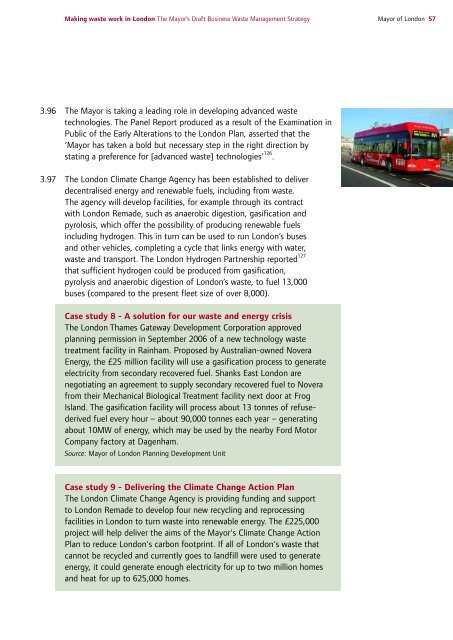Draft Business Waste Strategy PDF - london.gov.uk - Greater ...
Draft Business Waste Strategy PDF - london.gov.uk - Greater ...
Draft Business Waste Strategy PDF - london.gov.uk - Greater ...
You also want an ePaper? Increase the reach of your titles
YUMPU automatically turns print PDFs into web optimized ePapers that Google loves.
Making waste work in London The Mayor’s <strong>Draft</strong> <strong>Business</strong> <strong>Waste</strong> Management <strong>Strategy</strong> Mayor of London 57<br />
3.96 The Mayor is taking a leading role in developing advanced waste<br />
technologies. The Panel Report produced as a result of the Examination in<br />
Public of the Early Alterations to the London Plan, asserted that the<br />
‘Mayor has taken a bold but necessary step in the right direction by<br />
stating a preference for [advanced waste] technologies’ 126 .<br />
3.97 The London Climate Change Agency has been established to deliver<br />
decentralised energy and renewable fuels, including from waste.<br />
The agency will develop facilities, for example through its contract<br />
with London Remade, such as anaerobic digestion, gasification and<br />
pyrolosis, which offer the possibility of producing renewable fuels<br />
including hydrogen. This in turn can be used to run London’s buses<br />
and other vehicles, completing a cycle that links energy with water,<br />
waste and transport. The London Hydrogen Partnership reported 127<br />
that sufficient hydrogen could be produced from gasification,<br />
pyrolysis and anaerobic digestion of London’s waste, to fuel 13,000<br />
buses (compared to the present fleet size of over 8,000).<br />
Case study 8 - A solution for our waste and energy crisis<br />
The London Thames Gateway Development Corporation approved<br />
planning permission in September 2006 of a new technology waste<br />
treatment facility in Rainham. Proposed by Australian-owned Novera<br />
Energy, the £25 million facility will use a gasification process to generate<br />
electricity from secondary recovered fuel. Shanks East London are<br />
negotiating an agreement to supply secondary recovered fuel to Novera<br />
from their Mechanical Biological Treatment facility next door at Frog<br />
Island. The gasification facility will process about 13 tonnes of refusederived<br />
fuel every hour – about 90,000 tonnes each year – generating<br />
about 10MW of energy, which may be used by the nearby Ford Motor<br />
Company factory at Dagenham.<br />
Source: Mayor of London Planning Development Unit<br />
Case study 9 - Delivering the Climate Change Action Plan<br />
The London Climate Change Agency is providing funding and support<br />
to London Remade to develop four new recycling and reprocessing<br />
facilities in London to turn waste into renewable energy. The £225,000<br />
project will help deliver the aims of the Mayor's Climate Change Action<br />
Plan to reduce London's carbon footprint. If all of London's waste that<br />
cannot be recycled and currently goes to landfill were used to generate<br />
energy, it could generate enough electricity for up to two million homes<br />
and heat for up to 625,000 homes.
















